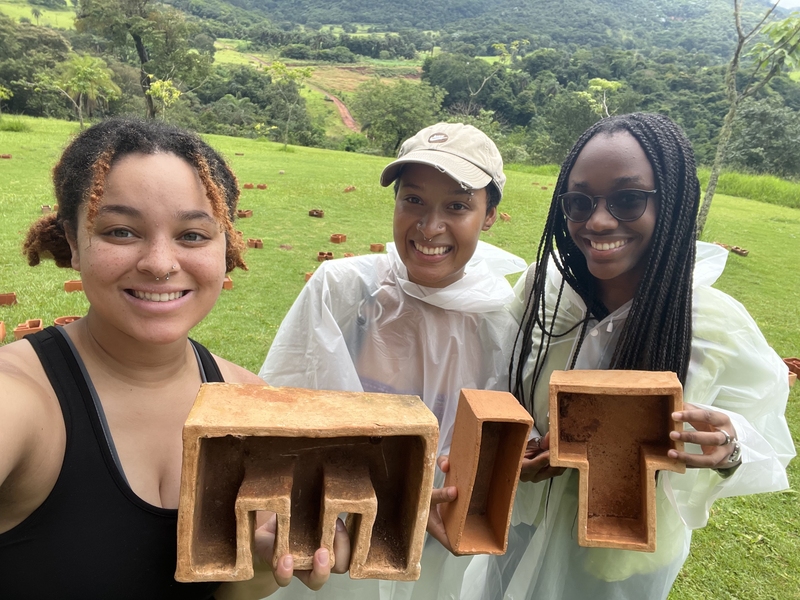In January 2024, at the height of Brazil’s summer, a group of 20 MIT undergraduates will arrive in São Paulo, Brazil, for the Independent Activities Period (IAP) course WGS.247/21L.592 (Race, Place, and Modernity in the Americas) jointly offered by the School of Humanities, Arts, and Social Sciences’ programs in Women’s and Gender Studies, Literature, and Writing.
Continuing a program developed in 2019 and launched as a special course in 2020, the three-week course offers students opportunities to study how American and Brazilian Black and Indigenous writers, artists, and filmmakers’ art and cultural activism — particularly women’s — can impact racial justice and environmental issues.
The class will visit historical sites, cultural centers, nature reserves, and museums while also engaging in conversations with local scholars, activists, religious leaders, community organizers, and artists.
By mixing classroom discussions with on-site exploration and cross-cultural exchanges, the course offers innovative pedagogy that is experiential (learning by doing), immersive (learning within an environment), and interdisciplinary (learning across different fields).
An immersive course, years in the making
Joaquin Terrones ’99, a lecturer in literature and women’s and gender studies, was already teaching this material when he considered expanding its scope. “It seemed like the natural next step was to take students to Brazil so they could experience its incredible culture, art, and activism for themselves,” he remembers.
In 2019, he and Wyn Kelley, a senior lecturer in literature, received a Higher Education Innovation grant from the MIT Jameel World Education Lab (J-WEL) to develop the course and teach it as a special subject the following year.
Generous support from MIT-Brazil, the Office of Minority Education, and MindHandHeart completed its transformation into a full-fledged course in women’s and gender studies, literature, and writing as part of MIT's Independent Activities Period (IAP) last January.
Helen Elaine Lee, a professor in MIT’s Comparative Media Studies/Writing program, co-taught the subject in its first full year, sharing her experiences using creative practices to further social justice.
Undergraduates from across MIT’s five schools, particularly Black, Latino, LGBTQ+, and first-generation college students, have enrolled. This outreach is important because some studies have shown students from these groups are underserved by study abroad programs, participating at significantly lower rates.
“Our students want spaces like the one created by this course to think deeply and collectively about the daunting array of crises we face, from catastrophic climate change to entrenched violence against communities of color,” says Terrones.
No day at the beach … well, maybe one or two
Although a few weeks in South America during January might sound like a vacation, the course is rigorous and intense, packing a semester’s worth of material into three weeks. Students spend mornings in seminar-style discussions, head out across the city for field trips in the afternoon, and return to their residences in the early evening for a few hours of readings or screenings.
For Tamea Cobb, a senior double majoring in chemical engineering and literature, the class trip to Rio led to an epiphany. “I remember waking up super early to watch the sunrise on the beach, where we saw a man practicing capoeira, an Afro-Brazilian martial art form disguised to look like dancing by enslaved Africans forbidden from practicing martial arts. We had just learned about capoeira the week prior, so it was a beautiful full-circle moment.”
In addition to class outings in São Paulo and Rio, students also organize their own weekend trips within Brazil to places such as Salvador, the unofficial capital of Afro-Brazilian culture, and Inhotim, a vast open-air art museum and botanical garden in the middle of the Atlantic Forest.
Beyond Brazil
The course’s impact continues well after its completion as participants incorporate what they learned into their work and lives.
“The course was a priceless experience that further revealed the interconnectedness of African experiences in the Americas,” says Afura N. Taylor ’21, who double majored in physics and writing. “It has influenced my writing by providing examples of literature and cultural practices that center ancestral memory.”
Educators also see benefits. “I had no idea it would give me a new research project on the presence of Brazil in Black U.S. print culture from the early national period to the present,” says Kelley.
In fact, the course’s success has inspired two new IAP subjects in Brazil this year: 21G.S07 (Language Conversation and Brazilian Culture) by Nilma Dominique from the Global Languages section, and 10.496/1.096 (Design of Sustainable Polymer Systems in the Amazon) by Professor Bradley Olsen in the Department of Chemical Engineering.
When asked what makes the course special, Professor Lee describes “[a] unique power [that] derives from rigorous discussions of challenging texts and films that question prevalent assumptions about history and politics, and immersive cultural experiences that open mind and heart, expanding and empowering students who often feel isolated and excluded on MIT’s campus.”
She adds, “In addition to deepening my intellectual and political understanding, this class gave me a profound experience of ancestral recovery that has fed my artistic work. For our Black, Latinx, and LGBTQ+ students, it was a liberatory experience of community. A re-education. A cultural and personal homecoming.”











